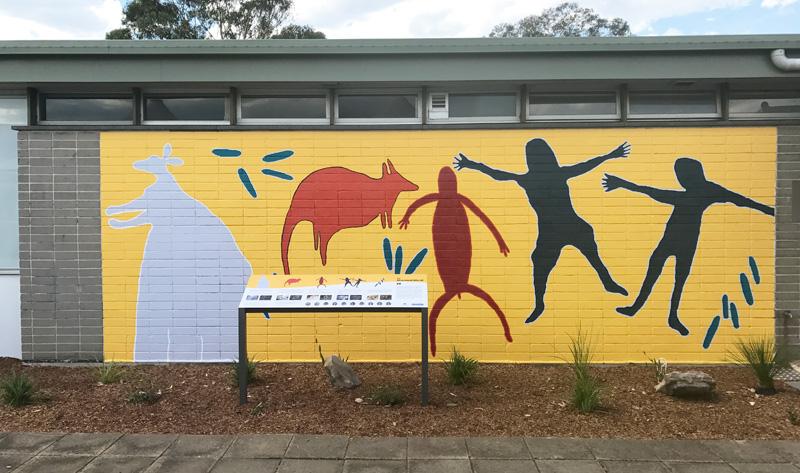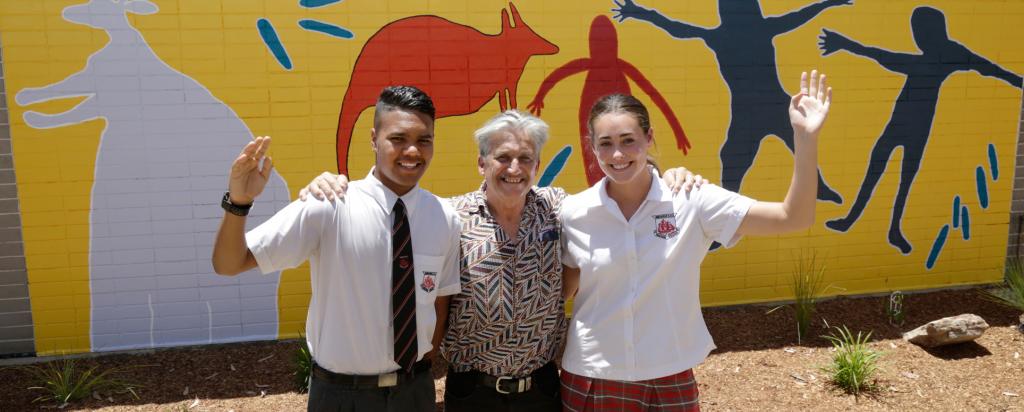

Published on the 18th December 2017 by ANSTO Staff
ANSTO is an authority of cutting-edge science, but looked into the past last week, with the completed mural representing significant Indigenous sites that can be found in the bushland surrounding the ANSTO campus in Sydney’s Lucas Heights.
The ceremony was held on Thursday formally thanked and recognised those who created the Dharawal Mural – students from Endeavour Sports High School – and unveiled an interpretative sign and plaque.
Led by their art teacher Rick O’Brien, the eight Strong Sister and Strong Brother Indigenous students painted the mural, adjacent to the ANSTO café, a publicly accessible part of the campus.
Les Bursill, a Dharawal elder, opened the event with a Welcome to Country in language.

The mural recreates five traditional images – of engravings, charcoal drawings, red drawings and grinding grooves – created by Dharawal people that are found within 5.5 kilometres of ANSTO.
CEO Dr Adi Paterson said it is wonderful to bring a piece of the rich Indigenous culture found within the Bardens Creek valley, to the ANSTO campus.
“Important cultural art and artefacts can be found in the valleys that surround us, but given their antiquity they are all heavily weathered and are difficult to spot if you don’t know where to look,” Dr Paterson said.
“ANSTO is privileged to have the mural on our campus – acknowledging the Indigenous heritage of the land of our workplace and surrounds.
“On behalf of ANSTO, I thank Bruce Howell, who provided the cultural information and images, Rick and the students Darcy, Ella, Izayah, Jayika, Kieran, Maya, Natasha and Tomysha for their efforts and Les Bursill.
“Some of the sites that this mural depicts are difficult to access and identify, so through these representations, we can recognise the Dharawal people, and connect the wider community to the rich history of the area.”
ANSTO liaises with the Dharawal people, the traditional owners of the land upon which the Lucas Height campus is located.
While ANSTO’s work may more typically be associated with nuclear medicine production, our scientists and researchers also extensively use the advanced research techniques to reveal more about ancient Indigenous cultural heritage.
ANSTO has been involved in numerous collaborations with indigenous groups, which have revealed some of the oldest known artefacts, and therefore oldest known occupations of Australia.
“ANSTO researchers have employed techniques including radiocarbon dating, and powder x-ray diffraction to analyse ancient samples found across the country,” Dr Paterson said.
“ANSTO was part of a team who proved the earliest occupation in Australia, at Madjedbebe, a site found on the traditional lands of the Mirarr people, surrounded by the Kakadu National Park.
“Our researchers have partnered with collaborators at Barrow Island in Northwest Australia, in the Northern Flinders Ranges and at other sites across the country, and with the support of indigenous peoples have investigated and dated ancient artefacts such as charcoal, shell, rock art and ochres.
“Using our advanced technology – at the Centre for Accelerator Science at Lucas Heights and ANSTO’s Australian Synchrotron facilities in Clayton, Victoria – we have been part of significant projects that have proven what may be the oldest sites in the world.
“As Australia’s home of applied science, we are always ready to be part of important research that uses cutting-edge science and technology to discover more about Australia’s past, to recognise and preserve these valuable relics, and reveal more about their origins.”
Media enquiries, please email media@ansto.gov.au
Read more about the cultural significance of the Dharawal art found in proximity to ANSTO